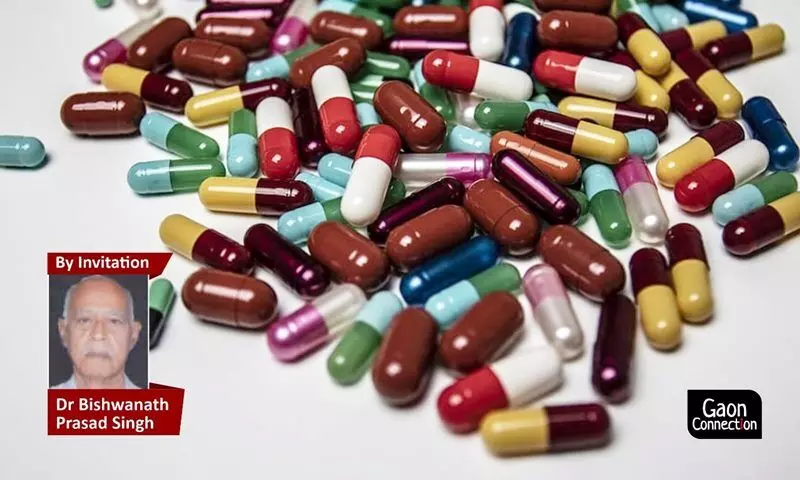Stringent regulations needed to limit the impact of antimicrobial resistance
Apart from introducing sharp regulations and increasing the monitoring and surveillance of pharmaceutical manufacturing sites that deter the degradation of rivers, the convergence of various stakeholders should also be prioritised.
 Dr Bishwanath Prasad Singh 28 March 2022 12:08 PM GMT
Dr Bishwanath Prasad Singh 28 March 2022 12:08 PM GMT

Despite several policy initiatives to reinvigorate our rivers, instances of unchecked discharge of sewage, agricultural waste, industrial, and pharmaceutical wastewater continues across the country.
Historically, rivers have been pivotal for human development. The Indus River birthed the Harappan civilisation — the earliest known human settlement in the Indian subcontinent.
With the passage of time, rivers assumed a greater significance in the socio-economic milieu of the region. In the Indian context, many rivers have been worshipped, as deities, thus signifying their cultural prominence. Additionally, trade routes on rivers mushroomed, and as a result, cities like Varanasi, Patna, Munger, and Kaveripattanam flourished. However, because of population growth, urbanisation, and industrialisation, the water in our rivers has degraded.
This degradation of our rivers has stark ramifications for the economy, environment, and public health. While the increasing toxicity of the rivers threatens the livelihoods associated with the marine economy, the degradation of the water quality endangers the lives of millions while posing an existential threat for our future generations. Pharmaceutical pollution: one of the casualties of the increased toxicity of our rivers, perfectly outlines the far-reaching consequence of degraded rivers on public health.
Also Read: Imagining a clean, urban river and lush-green riverbanks where people come together
Already recognised by the World Health Organization (WHO) amongst the 10 most dangerous public health threats; antimicrobial resistance (AMR) sees an uptick due to overuse of medicines by humans; misuse of antibiotics to boost production in agriculture, aquaculture, livestock; and irresponsible dumping of untreated wastewater in water bodies during the manufacturing process of antibiotics and other pharmaceuticals.
A further increase in AMR would be catastrophic, as it would induce 10 million deaths every year by 2050 and push an estimated 28 million people into poverty.
Collective effort needed
While various countries, including India, have implemented action plans to arrest the spread of AMR, the progress on mitigation of AMR due to activities like pharmaceutical pollution has been limited.
In what could have been a game-changer, the central government had prepared draft standards to govern 121 types of antibiotic residues, but they were never formalised. The absence of such standards allows the proliferation of antibiotic pollution of rivers as is the case in the Baddi pharmaceutical hub in Himachal Pradesh.
Also Read: Rejuvenating mighty rivers like the Yamuna and the Ganga requires the revival of smaller streams
Independent investigation of the water of the Sirsa river had revealed that the concentration of highly potent antibiotics like ciprofloxacin downstream was more than 1,500 times the acceptable base value. Such instances of antibiotic pollution are particularly problematic as AMR can spread to even far-off locations from the pharmaceutical hubs.
Like, in this case, the antibiotic pollution of the Sirsa river that joins Sutlej in Roopnagar, puts the lives of millions of inhabitants of Punjab at risk. While the Central Pollution Control Board (CPCB) has recently advocated for the adoption of predicted no-effect concentration (PNEC) criteria, it is important to ensure that these measures are implemented by the various state pollution control boards in letter and spirit.
Since the 1990s, the Indian pharmaceutical sector has come a long way. Today, we are one of the largest producers of pharmaceuticals in the world, and the industry is set to grow further with the recent impetus on domestic production of Active Pharmaceutical Ingredients (APIs). While businesses must have an enabling environment to flourish, it cannot be done at the cost of our rivers and public health. With a large population disposed to non-communicable diseases (NCDs), the build-up of AMR could be more damaging to the society and economy than the COVID-19 pandemic.
Apart from introducing sharp regulations and increasing the monitoring and surveillance of pharmaceutical manufacturing sites that deter the degradation of rivers, the convergence of various stakeholders should also be prioritised. There is a need to bring various ministries of the government such as agriculture, environment, animal husbandry and livestock, and chemicals and fertilisers on a common platform to avoid policy overlaps and ensure coherent policy actions.
In addition to this, setting up a nodal agency, on the lines of the proposed National Authority for Containment of AMR (NACA) would streamline the implementation of AMR containment activities throughout the country.
Lastly, like COVID-19, the mitigation of AMR would only be possible through the support of citizens, academia, and civil society organisations since the AMR menace needs a collective effort.
Bishwanath Prasad Singh, retired wing commander, is the general secretary of the Veterans Forum for Transparency in Public Life. Views are personal.
More Stories




